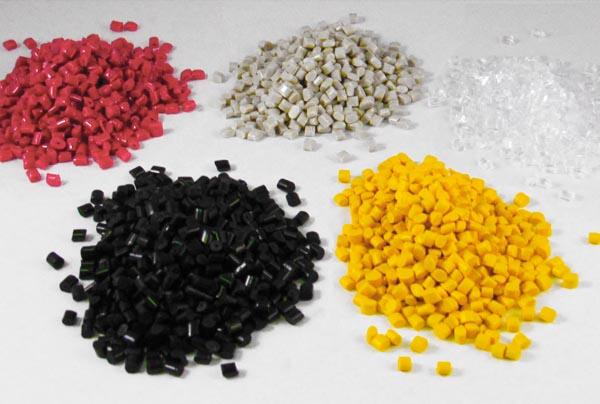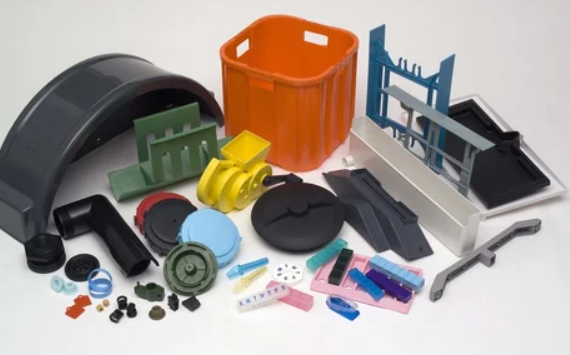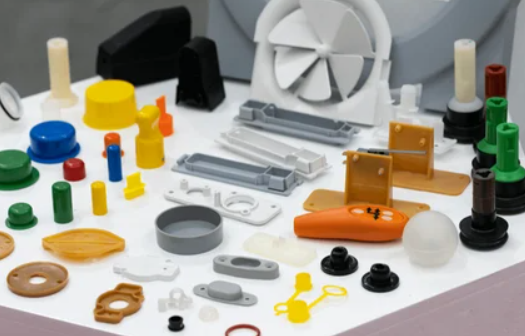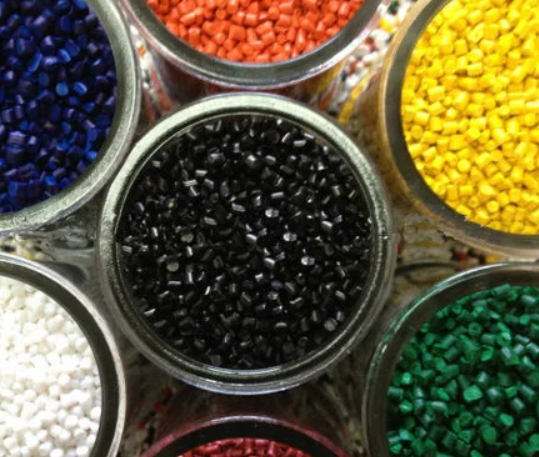Polypropylene and ABS have distinct advantages; the best choice depends on the specific application requirements.

Basics of Plastic Materials for Injection Molding
Injection molding stands as a premier manufacturing process for producing plastic parts with high accuracy, excellent surface finish, and complex geometry. Manufacturers choose this method for its efficiency, speed, and ability to produce parts at a high volume with consistent quality. The cornerstone of successful injection molding is selecting the appropriate material, which impacts the product’s performance, durability, and cost-effectiveness.
Understanding Thermoplastics
Thermoplastics represent a category of plastics that become moldable upon reaching a certain temperature and solidify upon cooling. This property makes them ideal for injection molding, where they can be melted, injected into a mold, and cooled to form the desired shape. Key advantages of thermoplastics include their recyclability and the ability to reheat and remold them multiple times without significantly altering their chemical structure or mechanical properties.
The selection of a thermoplastic material involves evaluating various attributes such as melt flow index, temperature resistance, and impact strength. For instance, manufacturers often prefer materials with a higher melt flow index for intricate part designs, as they can fill molds with greater ease.
Introduction to Polypropylene (PP)
Polypropylene, abbreviated as PP, is a versatile thermoplastic polymer known for its excellent chemical resistance, elasticity, and fatigue resistance. With a typical melting point around 130°C to 171°C, PP is suitable for various applications, from automotive parts to consumer goods.
- Chemical Resistance: PP does not react with water, detergents, acids, and bases, which makes it suitable for containers and medical equipment.
- Elasticity and Fatigue Resistance: Products made from PP, like living hinges, can withstand the rigors of repetitive stress.
- Cost-Effectiveness: It generally offers a lower cost than many other plastics, making it a budget-friendly option for large-scale production.
Introduction to Acrylonitrile Butadiene Styrene (ABS)
Acrylonitrile Butadiene Styrene or ABS is a thermoplastic polymer known for its rigidity, gloss, and toughness. It typically melts at a temperature range of 190°C to 220°C. ABS is widely used in applications requiring good dimensional stability and high impact resistance, such as in the manufacturing of LEGO bricks.
- Surface Finish: ABS provides a high-gloss surface, which is desirable for consumer-facing products.
- Strength and Toughness: With a tensile strength of about 46 MPa, ABS is strong enough for parts that must endure stress and strain.
- Machinability: ABS is easy to machine, paint, and glue, which allows for greater flexibility during the post-production phase.
Properties of Polypropylene (PP)
Polypropylene is a widely used plastic polymer that manufacturers prefer for a variety of applications due to its outstanding chemical and physical properties. Recognized for its balance of workability and performance, PP serves as an excellent choice for products ranging from packaging and textiles to automotive parts and medical devices.
Chemical Resistance
Polypropylene is highly resistant to a wide array of chemicals, making it an optimal material for containers and pipework in the chemical industry. It is impervious to dilute acids, dilute alkalis, and most organic solvents at room temperature. For example, a PP container can hold a 30% hydrochloric acid solution at 20°C without showing any sign of degradation over time. Its resistance to chemical absorption and degradation ensures a product’s longevity and maintains material integrity.
Temperature Tolerance
PP has a high thermal resistance compared to many other plastics, withstanding temperatures up to 160°C before deforming. This characteristic makes it a preferred choice for household appliances and automotive parts that must endure high-temperature environments. For instance, dishwasher-safe containers and car battery casings take advantage of PP’s thermal endurance.
Durability and Impact Strength
Durability is one of PP’s strong suits. The material exhibits an excellent strength-to-weight ratio. With an impact strength that can be as high as 3 kJ/m2, PP components can survive substantial drops and impacts without cracking. This level of durability often translates into a longer lifespan for products, making PP an economical choice over time.
Flexibility and Fatigue Resistance
Flexibility and fatigue resistance are essential for materials used in hinges or components that bend repeatedly. PP excels in this area, maintaining its shape after numerous flexes or twists. This fatigue resistance is quantifiable: PP can endure over 1 million cycles of bending without failure. Such a feature is crucial for creating durable, flexible parts such as snap-on lids, pump dispensers, and reusable containers that require repeated use.
Properties of ABS
Surface Finish and Aesthetics
- Gloss Potential: ABS can achieve a high-gloss finish similar to that of painted surfaces, which is particularly attractive for consumer goods.
- Color Retention: It holds color well, resisting fading or discoloration over time, critical for product longevity.
- Surface Smoothness: ABS parts are characterized by their smooth surfaces, reducing the need for post-processing.
Strength and Toughness
- High Tensile Strength: ABS can exhibit tensile strengths of 27 to 52 MPa, making it a robust choice for structural applications.
- Shock Absorption: With an impact resistance of 600 J/m, ABS can endure drops and blows without fracturing, vital for protective devices.
- Scratch Resistance: It is resistant to scratches and surface wear, maintaining its appearance under rough conditions.
Electrical Insulation Properties
- Dielectric Strength: ABS has an excellent dielectric strength of 16-35 kV/mm, ensuring it acts as a reliable insulator in electrical applications.
- Volume Resistivity: With a volume resistivity between 10^15 and 10^17 ohm-cm, ABS is effective in protecting against electrical hazards.
- Low Conductivity: It possesses inherently low thermal and electrical conductivity, enhancing safety in electrical enclosures.
Machinability and Glueability
- Ease of Machining: ABS can be easily machined to tight tolerances, allowing for precision components.
- Adhesive Compatibility: It bonds well with various adhesives, providing strong joints in composite assemblies.
- Post-Processing Flexibility: ABS can be easily painted, glued, or welded, offering versatility in manufacturing and repair.

Comparison Between Polypropylene and ABS for Injection Molding
When it comes to selecting materials for injection molding, both polypropylene (PP) and acrylonitrile butadiene styrene (ABS) offer distinct advantages and limitations. Understanding these can guide manufacturers in choosing the most suitable material for their specific needs.
Material Behavior Under Injection Molding Conditions
- Polypropylene (PP): Known for its low density, PP flows easily into molds, which can be advantageous for intricate designs. However, it has a higher thermal expansion coefficient, which may lead to dimensional issues if not properly accounted for.
- ABS: ABS exhibits excellent thermal stability and provides a more consistent dimensional accuracy than PP. Its superior rigidity can also reduce warpage during cooling.
Mold Filling and Cycle Time
- PP: Offers faster cooling times due to its lower melting temperature. This can result in shorter cycle times, which is beneficial for high-volume production runs.
- ABS: Although ABS might require longer cooling times than PP due to its higher melting point, it fills molds with greater precision, which is critical for complex parts with tight tolerances.
Post-Molding Operations
- PP: Post-molding modifications can be a challenge due to its chemical resistance, which makes bonding and painting more difficult.
- ABS: ABS parts are easier to paint, glue, and bond after molding, making it ideal for products that require a high-quality finish or additional assembly.
Environmental Considerations
- PP: It’s often touted for its sustainability profile, being lighter which reduces shipping emissions and being easily recyclable.
- ABS: While ABS is also recyclable, it is not biodegradable and its production is more energy-intensive compared to PP. However, its durability might lead to longer-lasting products.
Cost Analysis
- PP: Generally, PP is less expensive per kilogram compared to ABS, which can significantly reduce raw material costs, especially in large-volume manufacturing.
- ABS: The cost of ABS is higher, but its strength and finish qualities may lead to lower costs in post-processing and finishing, offsetting the initial material expense.

Applications of Polypropylene in Injection Molding
Consumer Goods
Polypropylene’s resilience and flexibility make it a preferred material for a variety of consumer goods. Items like food containers capitalize on its FDA approval for food contact and its ability to withstand dishwasher temperatures. Toys and outdoor furniture benefit from its UV resistance, ensuring long-term durability even when exposed to sunlight. With a low material cost, polypropylene helps manufacturers keep prices competitive, a critical factor in consumer markets.
Automotive Components
The automotive industry employs polypropylene extensively for both interior and exterior parts. Bumpers, dashboards, and door panels made from polypropylene not only reduce the vehicle’s weight, thus improving fuel efficiency, but also offer resistance to the stresses of daily operation. For example, a typical polypropylene bumper can withstand minor impacts without permanent deformation, highlighting its utility in automotive safety design.
Medical Devices
Medical device manufacturers utilize polypropylene for its sterilization compatibility and chemical resistance. Surgical instruments, syringes, and medicine bottles often feature polypropylene due to its ability to undergo steam sterilization without material degradation. This, coupled with its cost-effectiveness, enables the production of high-quality, disposable medical devices.
Applications of ABS in Injection Molding
Electronics Housings
ABS’s superior electrical insulation properties make it indispensable for electronics housings. Its blend of rigidity and impact resistance protects delicate internal components, while also offering an aesthetically pleasing exterior. For instance, the enclosures for power supplies and routers benefit from ABS’s shielding capabilities, which enhance user safety and device performance.
LEGO Bricks: A Case Study
LEGO bricks are a testament to the precision and durability of ABS in injection molding. The bricks, which require a tight fit and consistent clutch power, exemplify ABS’s dimensional stability and strength. LEGO reports that their bricks have a tolerance as low as 10 micrometers, demonstrating the high precision achievable with ABS.
Automotive Interior Parts
ABS sees substantial application in automotive interiors, where components such as dashboard trim, knobs, and air vents require a balance of aesthetic appeal and physical performance. Its ability to be colored and molded with fine details aligns with the automotive industry’s design specifications and durability requirements, offering a premium look and feel without a significant increase in production costs.

Factors Influencing the Choice Between Polypropylene and ABS
The decision to use polypropylene or ABS in injection molding hinges on several factors, each playing a pivotal role in the overall performance and suitability of the finished product.
Design Complexity
- Polypropylene: It has a lower melting point, which makes it flow into molds more easily. This is essential for intricate designs and fine details. However, designers must consider polypropylene’s thermal expansion, which can affect the precision of the final product.
- ABS: ABS tends to be preferred for items with high complexity due to its excellent dimensional stability and rigidity, which help maintain the integrity of detailed features during the molding process.
Aesthetic Requirements
- Polypropylene: While it can be made in various colors and does have a natural translucence, achieving a high-gloss finish is more challenging with polypropylene compared to ABS.
- ABS: Known for its ability to be polished to a high-gloss finish and excellent color retention, ABS is often chosen for products where appearance is a key factor.
Mechanical Performance Criteria
- Polypropylene: It’s chosen for its fatigue resistance, making it ideal for products like living hinges. However, it’s not as tough as ABS, which may be a limiting factor for high-impact applications.
- ABS: With higher tensile strength and superior impact resistance, ABS is the go-to material for items that require durability and strength, such as protective equipment and enclosures.
Environmental and Chemical Exposure
- Polypropylene: Due to its resistance to chemicals and water, polypropylene is often used for containers and parts that will be exposed to harsh environments.
- ABS: Although ABS can be compromised by certain chemicals and UV exposure, it’s still a strong contender for various applications due to its overall resilience and performance.
Production Volume and Cost Considerations
- Polypropylene: Generally, polypropylene is more cost-effective than ABS, which can significantly reduce the per-part cost in high-volume production. This makes it a popular choice for disposable items and mass-produced goods.
- ABS: While the material cost for ABS is higher, its finishing qualities often negate the need for post-processing, potentially lowering overall production costs for products requiring a high-quality surface finish. Additionally, its strength may reduce the need for redesigns or replacements, contributing to cost savings over time.




